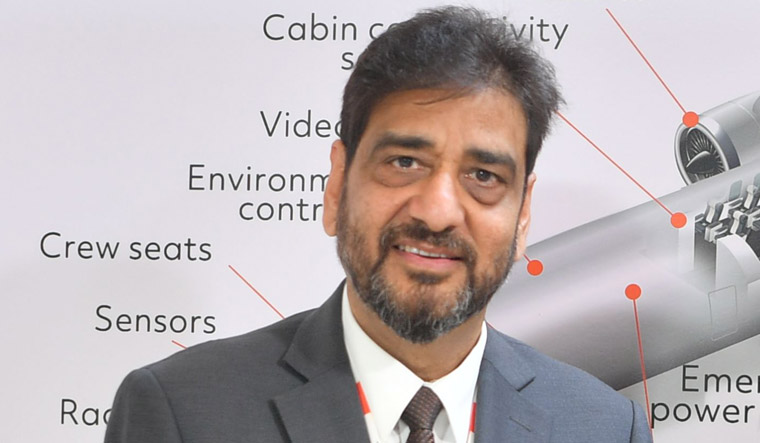Sunil Raina is the Managing Director, Customer and Account Management for Collins Aerospace in India. He leads Collins Aerospace's operations and provides strategic direction for the company’s initiatives in India. Besides this, he is responsible for business development activities for current and future programmes, spanning both commercial and defence markets.
Raina joined Rockwell Collins in Singapore in 2005 and has been involved in defining the strategies for the company’s air transport, general aviation and services businesses. Previously, he had led the Rockwell Collins Commercial Systems division in India and was successful in developing customer relationships and positioning the company as the preferred avionics partner for airlines in the Indian subcontinent. He is an Electronics Engineering graduate from Pune University and is a postgraduate in management. In an interaction with THE WEEK, he talks about the immense opportunities in the Indian aerospace market and how Collins Aerospace plan to tap it. He also speaks about the different projects they are doing in India.
What potential does Collins Aerospace find in the Indian aerospace market?
India has become the third-largest domestic aviation market in the world and is expected to overtake the UK to become the third-largest air passenger market by 2024. The Indian aerospace industry, both military and civil, is in an exceptional position today, on the threshold of catapulting itself into the global arena. Collins Aerospace is bullish about the market growth. The sector has put itself on a strong path towards a revolutionary transition as a result of the government's resounding support and involvement in the demand and supply of defence and civil aerospace products. The rapid growth of this industry has attracted major global aerospace companies to India.
This year’s union budget gave further impetus to the sector when Finance Minister Nirmala Sitharaman announced the building of new airports, heliports, water aerodromes and advanced landing grounds that will help in improving aerial regional connectivity. The Airport Authority of India (AAI) and other airport operators have earmarked capital outlay of nearly Rs 98,000 crore for the construction of greenfield airports and new terminals, expansion and modernization of existing terminals, and strengthening of runways, among other activities, across the country by 2025. The infrastructure growth with the building of new green airports and revamping older airports will help the aerospace industry grow further.
Besides this, the Indian government has implemented several laws and regulations to bring the country's MRO (Maintenance, Repair, and Overhaul) industry up to par with international standards. These initiatives include encouraging businesses to open MROs in India by reducing the Goods and Services Tax (GST) on domestic MRO services. MROs can now import tools, tool kits and spare parts duty-free, and 100 per cent of Foreign Direct Investment (FDI) can now be made through the automatic route.
Please elaborate the work you are doing with HAL, BEL and other defence setup in India?
We have a long history of supporting India and have significant content on a number of platforms currently in use by the Indian Air Force (IAF). Apart from content on the indigenous Light Combat Aircraft LCA Tejas Mk1, the list of platforms supported by us includes C17s, C130Js, P-8Is, AH-64Es, CH-47Fs, MH-60Rs, Jaguars and Hawks. Building upon our success on the LCA (Light Combat Aircraft) Mk1 programme, we are eager to work with ADA (Aeronautical Development Agency) and HAL (Hindustan Aeronautics Limited) to support them on new aircraft platforms under development in India like LCA Mk2, TEDBF (Twin Engine Deck Based fighter) and AMCA (Advanced Medium Combat Aircraft) Programmes.
In addition to this, we also work closely with HAL Bengaluru, Lucknow and Kanpur on sustaining key legacy platforms in use by IAF like Jaguars and Hawks through provisioning of spares and repairs of systems to ensure sustainment of these legacy platforms over the next several decades. We are presently working with HAL on setting up of licensed repair and overhaul of some key systems on platforms currently in use by IAF.
How is this whole scenario regarding sustainability in defence and what role is Collins Aerospace playing in this space?
We deliver a broad spectrum of advanced, battle-proven solutions in all domains, in both manned and unmanned platforms that serve the war fighters of today and tomorrow. We leverage technologies across our commercial and military market segments that provide increased flexibility as well as reduced total life cycle and acquisition costs through open systems and commercial-off-the-shelf technology solutions. We are backed by a global network of service and support to increase mission readiness. Our Mission System capabilities include simulation and training, defence sustainment, intelligence, surveillance and reconnaissance, ejection seats, airborne and ground connectivity, displays and power and controls.
What are the new areas Collins Aerospace is focusing and how are they relevant to the Indian aerospace market?
India is strategic to the global growth and investment strategy of all Raytheon Technologies’ businesses, including Collins, and India’s progressive government policies, good governance and huge pool of English-speaking talent will help drive the country’s contributions as a global leader in aerospace and defence. We believe the India growth story looks very promising over the next two to three decades. We are fully committed and invested in India, helping to realize its ambitions of Make-In-India by adding more jobs in the country and continuously enhancing the skill sets of our workforce. We will invest over $200 million in engineering and manufacturing capabilities and hire an additional 2,000 highly skilled employees in the Indian aerospace and defence sector over the next five years. We would be focusing on certain strategic areas such as connected ecosystems involving digital enablement and transformation with end-to-end solutions and services. We would also be focusing on electrical propulsion and aircraft systems for sustainable aviation and also system-controlled complex tasks, including the evolution to autonomous flight. At the same time, we would also be working on optimization of all cabin design aspects to meet evolving operator and passenger expectations etc.




